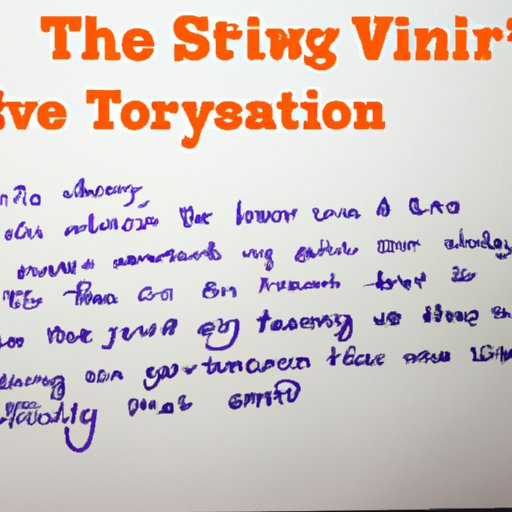Introduction
Writing a movie script is no small feat. It requires a lot of research, planning, and creativity. But with enough dedication and practice, anyone can learn how to write a great screenplay.
A movie script is a blueprint for a film. It includes all the elements that go into making a movie, such as the plot, characters, dialogue, action, and setting. In order to write a successful script, you must understand the fundamentals of storytelling and have a strong grasp of the filmmaking process.
This guide will provide an overview of the writing process, from researching your chosen genre to constructing scenes and writing the first draft. By breaking down the process into manageable steps, you can learn how to write a movie script and bring your story to life.

Research the Genre of Film You Want to Write
Before you begin writing, it’s important to have a good understanding of the genre you’re working in. Different genres have different conventions that you should be aware of when crafting your own story.
Consider what appeals to you. Do you prefer action movies or comedies? Romance or horror? There’s no right or wrong answer here; it’s simply a matter of personal preference. Once you’ve identified a few genres that interest you, do some research on them.
Learn about the different genres and their tropes. Research popular films within these genres and take note of the elements that make them successful. Identify what makes a good story in your chosen genre and use this knowledge to inform your own writing.

Create a Detailed Outline of Your Story
Once you’ve done your research, it’s time to start outlining your story. This is an important step in the writing process, as it allows you to plan out the structure of your script and get a better understanding of your characters and their motivations.
Begin by brainstorming ideas. Jot down any thoughts or images that come to mind. Then, develop a three-act structure for your story. This is the most common form of storytelling, and it consists of a beginning, middle, and end. Flesh out your characters and establish your theme. The more detail you add to your outline, the easier it will be to write the actual script.

Develop Your Characters and Their Motivations
Your characters are the driving force behind your story, so it’s important to give them depth and complexity. Get to know your characters by asking questions about them: Who are they? What do they want? Why do they act the way they do? Understanding their goals, desires, and fears will help you create believable, relatable characters.
You also need to make sure your characters have a reason to act. Every action should have a motivation, and every scene should advance the plot in some way. If your characters’ actions don’t make sense, your story won’t hold up.
Construct Your Scenes With Dialogue, Action, and Description
Now that you have your story outlined and your characters developed, you can begin constructing your scenes. Start by breaking down each scene into its component parts: dialogue, action, and description. Dialogue is used to move the plot forward and reveal character traits. Action is used to evoke emotion and keep the audience engaged. Finally, description is used to set the tone and atmosphere of the scene.
When writing dialogue, focus on making it natural and engaging. Avoid expositional dialogue, which is when characters tell each other things they already know. Instead, have your characters interact with one another in interesting ways. Make sure the action is compelling and moves the story forward. And when describing the setting, try to evoke a sense of place and atmosphere.
Write the First Draft of Your Screenplay
Now it’s time to start writing. Take your outline and start filling in the blanks. Don’t worry too much about spelling and grammar at this stage; just focus on getting your ideas down on paper. Keep writing and don’t stop until you reach the end. As you write, take notes on what works and what doesn’t.
Once you’ve finished your first draft, it’s time to start editing. Read through your script and make changes where necessary. Ask for feedback from friends, family, or other writers and use their comments to improve your draft. Keep editing until you’re happy with the result.
Conclusion
Writing a movie script can be a daunting task, but with enough dedication and practice, anyone can learn how to write a great screenplay. This guide provided an overview of the writing process, from researching your chosen genre to constructing scenes and writing the first draft.
(Note: Is this article not meeting your expectations? Do you have knowledge or insights to share? Unlock new opportunities and expand your reach by joining our authors team. Click Registration to join us and share your expertise with our readers.)
